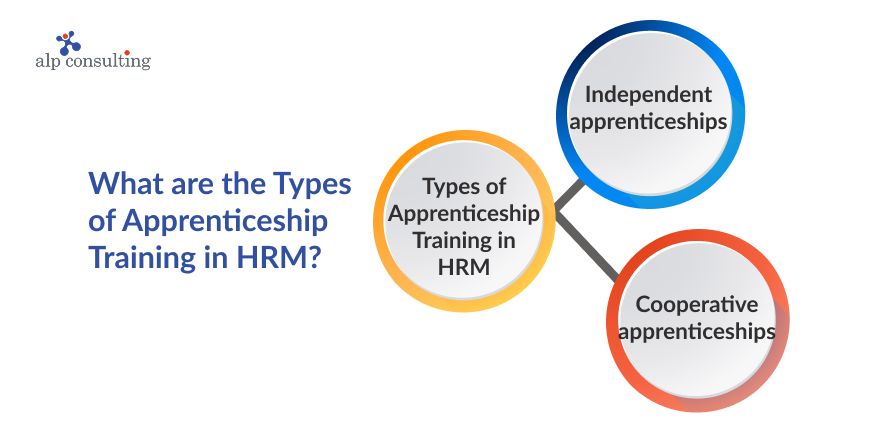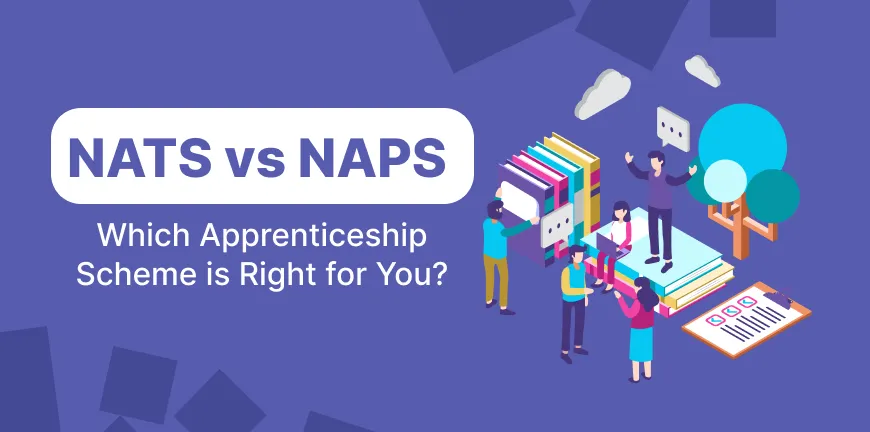
What is Contract to Hire? Definition, Process & Benefits
13/07/2023
What is NATS? Definition, Benefits & Eligibility
24/07/2023- Apprenticeship Definition:
- What are the Objectives of Apprenticeship Training in HRM?
- What are the Benefits of Apprenticeship Training?
- What are the Types of Apprenticeship Training in HRM?
- What is the Eligibility for National Apprenticeship Training Scheme?
- How to Apply for Apprenticeship Training?
- Where to Find the Best Apprenticeship Training Providers in India
- Alp Consulting as a Partner in Apprenticeship Training Journey
- Closing Words
- FAQs
The ILO (International Labor Organization) has a clear definition of apprenticeship training as it applies in HRM. It says that apprenticeships are a unique form of technical and vocational training that combines on-the-job skill development with off-the-job learning to become better at a particular occupation. The length of an apprenticeship program varies across job roles, sectors, professions and cultures.
Apprenticeship Definition:
To put it simply, an apprenticeship meaning can be explained as a kind of training system where one is trained to learn a skill or trade from an expert in a designated period of time. Countries like Germany, Austria, Switzerland, etc., are well known for their apprenticeship training methods. According to the ILO, India too has an apprenticeship training program, which is a good example of how a country focused on its goals can, even with less publicity, be very good and grooming many young minds for the job
What are the Objectives of Apprenticeship Training in HRM?
An apprenticeship training program, such as NATS (National Apprentice Training Scheme), especially one instituted for the growth of individuals, individual companies and the nation must have certain objectives it must fulfil from the perspective of a candidate who applies for it. The main objectives of any apprenticeship training in HRM is to develop all-round progress in applicants in three key areas, improving competence over time:

1. Knowledge
To impart the necessary knowledge to carry out the occupation in a meaningful manner and to satisfy basic conditions required of the job.
2. Skills
To impart the necessary skills also to carry out the job or occupation in an exceptional manner and to satisfy key performance indicators at work.
3. Behaviour
To change the temperament and to elevate the emotional intelligence of candidates, allowing them to work more effectively in a team or compete with others in the specific job role.
What are the Benefits of Apprenticeship Training?
We discussed in the previous section how apprenticeship training will help the apprentice. But what are the benefits of apprenticeship training for the organization? Apprenticeship training will help boost the confidence of applicants and improve their skill levels. From a company perspective,
1. This will help build more competent teams and a transfer of skills to those inducted newly into teams.
2. Upskilling and continuous learning and development will be the norm at work.
3. People will work faster and together and become more skilled and productive to improve an organization’s reputation and finances.
What are the Types of Apprenticeship Training in HRM?
The trades that will be worked on by apprentices will be designated or optional. The designated trades are notified and assigned by the government, whereas the optional trades are decided by the employers. There are only two types of apprenticeship training methods, and this depends on the kind of involvement that the stakeholders have in the process.

1. Independent apprenticeships are managed by employers and educational institutions have no role to play in it. They are more real-world practice driven and specific use cases for the occupations will be discussed more than theory.
2. Cooperative apprenticeships are managed with the cooperation of employers and educational institutions. The extent of governance of each party will vary from one apprenticeship to another. But the apprenticeships are curriculum driven in this case, with knowledge being imparted first followed by real-world practice, which gives professional autonomy to the apprentices.
What is the Eligibility for National Apprenticeship Training Scheme?
To apply for the National Apprenticeship Training Scheme (NATS) subject to the specific provisions of the scheme, all the applicants must fulfil the following criteria:
- Age must be above 16 years on the date of application, with the birth certificate or other valid certificates being proof.
- A degree/diploma is absolutely essential to undergo the NATS training.
- Must not have undergone training under any other Government provided skill development programme.
- Must not be self-employed or partnered in a business.
- Must not have been dismissed from Government service.
How to Apply for Apprenticeship Training?
If an establishment has a headcount between 7 and 39, then they are eligible to apply for the NATS program. As per Government of India guidelines, establishments having a headcount of over 40 mandatorily have to engage apprentices.
Documents required
The enrolment process requires an initial eligibility assessment. Several documents must be presented to prove eligibility for apprenticeship training. The establishment must also have a dedicated mobile number to receive the OTP to complete the process. The documents required to complete the eligibility assessment are:
- Certificate of incorporation
- PAN/TAN
- Income Tax return from the last year
- Details on sexual harassment of women framed by an internal committee
- Total manpower details in different employment types (onroll, contractual, temporary, outsourced etc.)
- The apprenticeship training module that will be implemented yearly
- Brief info about the establishment (less than 1MB size PDF)
- Mobile number
Note:
The establishment must attest every document it submits, affixed with office seal and it must be uploaded in PDF format with maximum size of 1MB each.
Enrolment
1. The establishment that wishes to apply under NATS must also read the enrolment guidelines clearly. After this they must initiate the process, with their documents in hand. They will be asked questions on the NATS portal, and they will need to provide their inputs.
2. After uploading certificate of incorporation, PAN/TAN and Income Tax return, the total manpower details would need to be entered. The establishment is also required to have an internal committee on safeguarding women at the workplace from sexual harassment to continue with NATS.
- If the establishment does not have a structured apprenticeship training module that will be implemented yearly, then it might delay the process of approval. In the company info space, the employer will need to mention the workplace address, the corporate office and the head office address.
Things to remember
- The system allows contract registration only within 7 days of the apprentice joining the establishment.
- If the establishment has a presence in more than 4 states across India, then it can register on a national basis for apprenticeship training.
- A valid email ID is also essential as all important communication will be sent to that ID.
- A bank account that is provided must be in the name of the establishment only.
- The stipend due to apprentices must be paid by the 10th of every month and no deductions shall be made from the stipend for casual leave or medical leaves.
- All information provided must be validated in August every year.
- On successful submission enrolment number and password for access to the portal will be displayed and the information will be shared over email and SMS also.
Where to Find the Best Apprenticeship Training Providers in India
Apprenticeship training providers are there in every state in India. When you opt for an apprenticeship training provider, you must check if it aligns with your business, trains the apprentices adequately, takes less time to increased efficiency and is priced in a cost-effective manner.
Alp Consulting has been in the NATS consulting space ever since its inception a few years back. We have been following NATS and NAPS closely and have been updating our training systems accordingly. We have industry-certified mentors who will be guiding the apprentices. Under our guidance, our clients have successfully built workforces that have satisfied their organizational requirements.
Alp Consulting as a Partner in Apprenticeship Training Journey
Your apprenticeship training journey must begin with Alp Consulting. When it comes to NATS scheme, there are four ways in which Alp Consulting can assist you as a third party service provider.
- Submitting apprenticeship contract on the portal on behalf of the employer.
- Posting details of all returns on behalf of the employer.
- Submitting claims for reimbursement along with attendance for every apprentice on the company payroll.
- Following trade apprentice formalities always.
Closing Words
Apprenticeship training is a journey not a destination. Learning is a continuous process that demands the best of mentors, the most robust of processes and dedication from all the stakeholders involved.
It helps build stronger workforces in companies and helps them cope in times of stress from external factors. It promotes a spirit of learning that never dies, apprentices gain from it and mentors can keep themselves keen and up-to-date too.
FAQs
1. What is apprenticeship training meaning in HRM?
Apprenticeship training is the process of improving the knowledge, skills and behaviour of apprentices in a particular job or vocation (technical or non-technical). The Government of India’s training program is referred to as NATS.
2. How long are apprenticeship programmes?
Apprenticeship programmes can be anywhere between a month to as long as a few years depending on the job role and the grade of the apprentice.
3. Do apprentices receive certification after completing a programme?
In India, apprentices will receive the certificate of training after the completion of NATS from the department they work for.
4. What is the difference between apprenticeship and internship training?
Apprenticeships often have a structured training program as opposed to an internship and happens under an industry-certified mentor. Apprenticeships are also converted into full-time more often than internships. You can earn a certificate at the end of an apprenticeship but not always for an internship.
Contact Us For Business Enquiry

Suresh Ramkrishna
Suresh Ramkrishna is the Operations Manager at Alp Consulting Ltd., with over 30 years of extensive experience spanning recruitment operations, sourcing, supply chain management, and client relations. At Alp, he leads the Search & Staffing Practice, specializing in bilingual and niche skill hiring while overseeing Japanese language and TITP (Technical Intern Training Program) initiatives. He also manages NAPS (National Apprenticeship Promotion Scheme) training programs, fostering skill development and workforce readiness across industries. Previously, he spent over two decades in the apparel export industry, managing vendor development and international sourcing for top global brands. Suresh’s leadership blends strategic talent acquisition with operational excellence across diverse industries.





